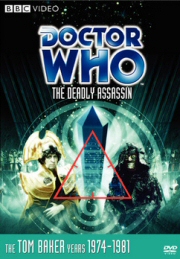The Deadly Assassin
- Sci-Fi
- 1976
- Buy the DVD
Reviewed by Ross Ruediger
()
efore moving on to more substantial matters, let’s address the elephant in the room: “The Deadly Assassin” may be the goofiest title ever given to a “Doctor Who” story, and it’s been pointed out by many before me (including, I believe, incoming showrunner Steven Moffat). After all, if an assassin isn’t deadly, he’s not much of an assassin, is he? The working title for the story was “The Dangerous Assassin,” which is even sillier. But the title is the worst thing about this story, so don’t let it dissuade you from imbibing in one of the most important “Who” stories ever created.
This is “Who” 101, and for anyone who cares to have a deeper understanding of how the mythology of the Time Lords was established, this is basic, must-see material. Noteworthy, possibly, is that it took the series 13 years to get to the point where someone (writer/script editor Robert Holmes) felt it was a good idea to delve this deeply into the society from where the Doctor originated. Prior to this, the workings of Gallifrey had only been glimpsed, shrouded in nebulous secrecy. But “The Deadly Assassin” came along and blew the whistle on the Doctor’s home planet, took away much of the mystery, and changed the underlying backbone of the series in ways that affect the core of “Who” to this day. Had it been a weak script, the mechanics of it may have ultimately been ignored, but instead it struck a chord and went on to become a benchmark tale in “Who” history. In an era when the show was routinely finding inspiration in classic horror and sci-fi films, it stood apart from the pack by unabashedly stealing elements from a political thriller: “The Manchurian Candidate.”
“Assassin” begins where “The Hand of Fear” left off (which makes it long overdue on DVD, since “Hand” was released three years ago). The Doctor (Tom Baker), having been summoned to Gallifrey, has a startlingly realistic vision of the President of the Time Lords being assassinated. He arrives on his home world under an immediate veil of suspicion, as the President is stepping down, and intends to name his successor. The first episode, which features a great deal of humor, largely establishes the stodgy, backwards way Time Lord society works, all while the Doctor eludes capture and tries to get to the bottom of his premonition. In the second episode, events escalate, and the Doctor discovers his old nemesis the Master (Peter Pratt) is behind everything, which leads to the Doctor hooking himself into and entering the virtual world of the Matrix, a massive computer containing the entirety of the Time Lord’s knowledge.
It has been claimed time and again, mostly by fans who feel something must be said, that the concept of the Matrix was ripped off by the Wachowskis for “The Matrix” series. As far as I know, they’ve not only never admitted to it, but they’ve never even been officially asked about the matter. It may very well have been a happy accident, although it would be something of a coup for “Who” if it was a direct steal. In any case, the similarities between the Time Lords’ Matrix and “The Matrix” are weirdly similar: Anything goes in the Matrix, and the rules of reality no longer apply. Further, once you’re plugged into it, if you die in the Matrix, you die in the real world. (Unfortunately, the effects budget of “Who” in the ‘70s didn’t allow for slo-mo kung-fu.) Episode Three takes place within the Matrix, while the Doctor battles not the Master himself, but a Time Lord puppet the Master is using to do his dirty work. It’s a surreal battle of wits, chock full of disturbing imagery that had ‘70s TV watchdog Mary Whitehouse champing at the bit, claiming this was just plain wrong for children to view – and probably with good reason. Objectively speaking, even 30-plus years on, I’d be amazed if the new series ever had the balls to go for some of the stuff “The Deadly Assassin” presents. It’s angry, visceral, and dare I say it, deadly.
Alright, alright, alright – little of the above qualifies the story as definitive. The story completely opens up the workings of Time Lord society. We see – for the first time – their attitudes, politics, personalities, prejudices, faults and most importantly, their humanity. Holmes basically presents a stodgy hierarchy, and gives perfectly good reason to the idea that the Doctor would want to run away from all of it (without ever explicitly addressing that very point). Gallifrey clearly wasn’t a stimulating environment in which to grow, and to think upon its original broadcast, this serial wasn’t terribly popular amongst hardcore fans. It was felt to be something of a betrayal of the mystery that had been built up over the years, and, to be fair, it was. But it was also a perfectly reasonable answer to one of the core questions of the series: Why did the Doctor run away from his own people, and why did he dislike them so? Although the answers to that question had been heavily hinted at before, “The Deadly Assassin” answered it in an effortlessly uncomplicated fashion. The serial also introduced such minutiae as the fact that Time Lords have 13 lives, the character of Borusa (here played by Angus McKay), who figured prominently into later serials, as well as the idea of the Time Lord Rassilon, who helped to make time travel possible for the Gallifreyans.
Probably the only element of the story that’s a letdown (especially by today’s standards) is the Master. He hadn’t been used on the series since the Jon Pertwee era, when Roger Delgado, who originated the character, was killed in a car accident. Here he is presented withered and decayed, having reached the end of his regeneration cycle. It’s an interesting idea, and integral to the plot, but the make-up used for actor Peter Pratt is little more than a static skeleton mask. Since it does not move, the character is mostly robbed of his rich personality. (Luckily, when the Master returned some years later in the same form in “The Keeper of Traken,” the make-up was given an overhaul.) Finally, it’s worth mentioning that the story is unique in that it’s the singular instance in the classic series of the Doctor having no companion – Sarah Jane had just left, and Leela was introduced in the next story. It was a bold experiment to have the Doctor fly solo, and while it wouldn’t have worked over the long haul, this was an ideal story to showcase the Doctor working alone.
Special Features: The commentary track features Baker, Bernard Horsfall (Chancellor Goth), and producer Philip Hinchcliffe, with the latter dominating the proceedings. Good stuff, and Hinchcliffe is always a fascinating man to hear from. “The Matrix Revisited” (kicked off by titles created to ape the Wachowski flicks) is a great making-of, as is to be expected. “The Gallifreyan Candidate” is a look back at the Richard Condon novel and its influence on the story. “The Frighten Factor” is a look at various scares throughout the show’s history. There are also the usual production notes subtitles, photo gallery, DVD-ROM accessible Radio Times listings and an Easter Egg.
You can follow us on Twitter and Facebook for content updates. Also, sign up for our email list for weekly updates and check us out on Google+ as well.













